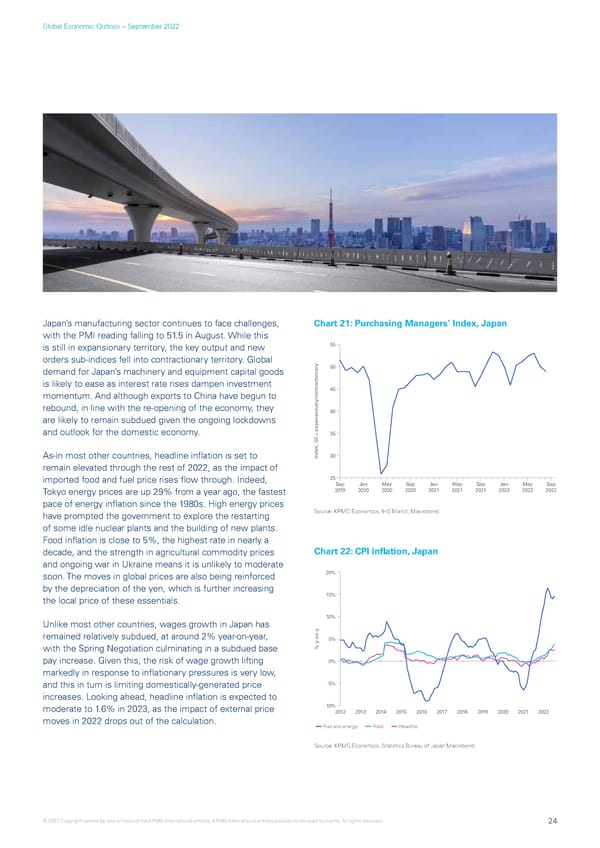Global Economic Outlook – September 2022 Japan’s manufacturing sector continues to face challenges, Chart 21: Purchasing Managers’ Index, Japan with the PMI reading falling to 51.5 in August. While this is still in expansionary territory, the key output and new 55 orders sub-indices fell into contractionary territory. Global demand for Japan’s machinery and equipment capital goods 50 is likely to ease as interest rate rises dampen investment 45 momentum. And although exports to China have begun to rebound, in line with the re-opening of the economy, they 40 are likely to remain subdued given the ongoing lockdowns and outlook for the domestic economy. 35 As-in most other countries, headline inflation is set to Index, 50 = expansionary/contractionary30 remain elevated through the rest of 2022, as the impact of imported food and fuel price rises flow through. Indeed, 25 Sep Jan May Sep Jan May Sep Jan May Sep Tokyo energy prices are up 29% from a year ago, the fastest 2019 2020 2020 2020 2021 2021 2021 2022 2022 2022 pace of energy inflation since the 1980s. High energy prices have prompted the government to explore the restarting Source: KPMG Economics, IHS Markit, Macrobond. of some idle nuclear plants and the building of new plants. Food inflation is close to 5%, the highest rate in nearly a decade, and the strength in agricultural commodity prices Chart 22: CPI inflation, Japan and ongoing war in Ukraine means it is unlikely to moderate soon. The moves in global prices are also being reinforced 20% by the depreciation of the yen, which is further increasing the local price of these essentials. 15% 10% Unlike most other countries, wages growth in Japan has remained relatively subdued, at around 2% year-on-year, -on-y5% with the Spring Negotiation culminating in a subdued base % y pay increase. Given this, the risk of wage growth lifting 0% markedly in response to inflationary pressures is very low, and this in turn is limiting domestically-generated price -5% increases. Looking ahead, headline inflation is expected to moderate to 1.6% in 2023, as the impact of external price -10% 2012 2013 2014 2015 2016 2017 2018 2019 2020 2021 2022 moves in 2022 drops out of the calculation. Fuel and energy Food Headline Source: KPMG Economics, Statistics Bureau of Japan Macrobond. © 2022 Copyright owned by one or more of the KPMG International entities. KPMG International entities provide no services to clients. All rights reserved. 24
 KPMG Global Economic Outlook - H2 2022 report Page 23 Page 25
KPMG Global Economic Outlook - H2 2022 report Page 23 Page 25